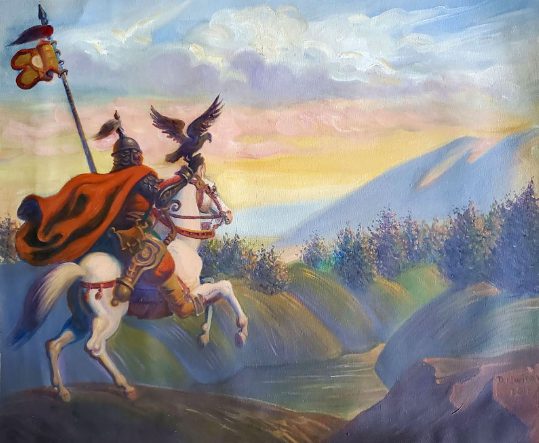The Timeless Art Of Portrait Painting: History & Evolution

Considering portrait painting as a unique art that can capture not only a person’s appearance, but also his inner world, emotions, experiences. Since ancient times, artists have sought to convey on canvas the character and state of mind of their models. Each portrait contains a whole story about the life, personality and time in which the person depicted lived. The main question remains, what are portraits today? Portraits continue to be a relevant genre, despite the fact that cameras have appeared in modern society and in fact, it has not overshadowed, but on the contrary, has given value to oil portraits; and new technologies and styles from artists make paintings more diverse and expressive, in some way realistic.
Painting experts helped write this material and for more details on this topic can be found here: https://ukrainianvintage.com/collections/portrait
It is believed that the first portraits appeared in ancient times, and of the oldest works we can refer to female faces, which are depicted in Greek frescoes of the 16th century BC. Before easel painting was invented, the canons of the portrait genre were not yet developed; but some depictions of people in the ancient world can be considered with reservations and called portraits.
Portrait painting dates back to ancient times – at the time when people sought to immortalize their images on rocks and in cave paintings. However, classical portrait painting, as we understand it today, first sprouted in ancient civilizations such as Egypt, Greece and Rome. Let’s look at each civilization briefly, for example, ancient Egypt became one of the first portraits in history where pharaohs and noble people were depicted. Portraits served a function in rituals and burials – the Egyptians believed that the image of a person would help his soul find a body in the afterlife. An example of this fact are the Fayum portraits – in simple terms, these are realistic images of the dead that were placed on sarcophagi. And in Ancient Greece and Rome, portrait painting and sculpture began to form as a separate genre; in contrast to the Egyptian tailoring tradition, the Greeks and Romans strove for realism and idealization of human nature. A realistic approach contributed to a certain growth in the development of artists and sculptors – they were actively searching for the study of ideal human proportions and perfected the techniques for depicting personality. In the ancient period – portraits were often a symbol of power and status, which can be seen in the busts of Roman emperors.
What development did the Greeks and Romans give in the genre of portrait painting?
The Greeks paid special attention to the harmony and beauty of the body, which was expressed in their desire to create ideal proportions corresponding to the concept of the “golden section”. What is the golden section? Simply put, the golden section – is a mathematical approach that allowed artists and sculptors to create images that embody a certain perfection of man in art. In the works of Ancient Greece, man was depicted not only as a physically perfect being, but also as the embodiment of spiritual harmony and wisdom. At the same time, the Romans brought another aspect to portrait art – individuality. Unlike the Greeks, who idealized their characters, Roman artists sought to convey real facial features, even if they were far from ideal standards of beauty. Roman sculptors and artists were not afraid to show wrinkles, expressions of age and character traits, which made their works more documentary and realistic. In general, the trend that was created – the transition from idealized images to a more realistic depiction of a person contributed to the further development of the portrait genre not only in painting, but in all art. Even then, one could see how portraits conveyed not only physical resemblance, but also the status, emotions and even political significance of the person depicted. It was the Romans who laid the foundation for what would become a characteristic feature of portrait art in the future – the desire to capture not only the appearance, but also the inner world of a person, his uniqueness and place in society.
Medieval Era of Portrait Development
Moving on to the Middle Ages, portraits became more symbolic and religious; saints and royalty were most often depicted, with the main emphasis not on realism, but on the spiritual greatness and significance of the depicted individuals. Faces were depicted in strict, elevated poses, with expressions of piety and holiness, and the background and details were often simplified so as not to distract attention from the spiritual content. In the Middle Ages, religious portraits, or in other words, iconography, played a key role in shaping the idea of art at that time. The main goal of medieval portraits was not to perpetuate appearance, as was the case in antiquity, but to strengthen religious faith and visualize divine messengers on earth. Icons played a special role, which were not considered ordinary images, but were objects of worship and intermediaries between man and the heavenly world. Artists strictly followed the established canons, creating works that were supposed to inspire awe and elevated feelings in believers. Portraits of rulers and noble persons were also often depicted in a religious context to emphasize their divinely chosenness and power granted from above. Kings and emperors were depicted surrounded by saints or with religious attributes, which emphasized their spiritual greatness and the inviolability of their status. In the Middle Ages, art and portraits played an important role in supporting and strengthening religious and social orders; iconographic images contributed to the formation of a visual culture in which a person was considered as something more than just a physical being – his soul and spiritual greatness were the focus of the art of that time.

The Renaissance in the Development of Painting
The next significant stage in the development of the genre came in the Renaissance – artists increasingly began to paint portraits without any utilitarian goals and were created for aesthetic pleasure. At the time when the influence of the church on society was weakening, the shackles in the revaluation of traditional views on the desire of a person to capture himself in certain moments of life also fell off – no more characteristic features of pride or other spiritual vices. A breakthrough for favorable conditions in the development of the genre was created by wealthy people who actively ordered portraits of their relatives or themselves from artists. At this time – new techniques appeared, such as chiaroscuro, perspective compositions and the use of oil, which made portraits more lively and expressive. Artists paid special attention to details, conveying the textures of skin, hair and clothing with exceptional accuracy; they sought to create the illusion of three-dimensional space on a flat canvas, using linear perspective and precise distribution of light and shadow. Which in turn allowed them to achieve the effect of volume and depth, making portraits more realistic; in addition, portraits of that time often included symbols and attributes indicating the status, profession or personal qualities of the person depicted. For example, in portraits of the nobility, one could see books, musical instruments or objects associated with power. Each object gave the work additional meaning, turning the portrait into a kind of visual story about the life and character of the model; we must not forget that the Renaissance saw the emergence of famous masterpieces: Albrecht Durer’s Self-Portrait, Leonardo da Vinci’s Mona Lisa, Raphael Santi’s Lady with the Unicorn. The Renaissance is considered the “golden age” of portrait painting.

Portraits among rich people
Starting from the 17th century – a new stage of development in portrait painting takes place and thanks to the achievements of the Flemish and Dutch schools. Representatives of these schools strove for greater realism and the transfer of all the versatility of human nature and at the same time, representatives of different social classes, nationalities and religious denominations increasingly appeared on canvases. One of the brightest representatives of this period was Rembrandt van Rijn, whose portraits were distinguished by incredible depth of psychology and subtle mastery in the use of light and shadow. It can be said that Rembrandt was an innovator in the technique of chiaroscuro and this allowed him not only to give volume to figures, but also to focus attention on the emotional state of a person. For example, the artist depicted people at moments when they were thinking or were in a state of reflection – this made Rembrandt’s works especially expressive and unique for the genre of portraits. But there were also Flemish masters who made a significant contribution to the development of portrait painting – these are Peter Paul Rubens and Anthony van Dyck. The first artist, Rubens, is known for his dynamic, energetic portraits, where attention was paid to the luxury and grandeur of the images; his works are filled with bright colors, which emphasized the social status and power of the characters. The second artist, Anthony van Dyck became known as a master of the ceremonial portrait, depicting European monarchs and aristocrats with elegance and nobility, making their images almost idealized.
Time passed, and portrait painting, thanks to the experiments of artists, developed and penetrated into different layers of society, for example, it was popular among wealthy burghers, merchants and representatives of the new class – the bourgeoisie. People from the bourgeois class strove to ensure that portraits not only demonstrated their well-being, but also emphasized their moral and spiritual qualities. As a result, the works of Dutch masters such as Frans Hals and Jan Vermeer showed a tendency to depict simplicity and modesty, without excessive idealization, but with an emphasis on the vitality and sincerity of the images. Thus, the 17th century became an important stage in the development of portrait painting, when realism, mastery of conveying light and shadow, as well as attention to the psychological and social aspects of the model reached a new level. Artists of this time – created works that not only reflected the external appearance of a person, but also revealed his inner essence, making portraits lively and multifaceted.
Portraits in the “New Time”
The Age of Enlightenment and Romanticism brought new ideas and styles to portrait painting – artists sought not only to capture appearance, but also to convey personal qualities, mood, as well as attitudes to social and philosophical issues of the time. Aristocrats and simply wealthy representatives of society ordered portraits from artists in order to primarily emphasize their social status, as well as their successes and achievements. However, elements of personal intimacy and individuality began to appear in portraits of the 18th and 19th centuries, which distinguished this period from the previous ones.
Let’s consider two artists, and the first is Francisco Goya, a Spanish master, known for his deeply psychological portraits that went beyond idealization. In his works, the artist often depicted people as they were, without embellishment and without exaggeration, which made his portraits honest and sometimes even harsh in comparison with other works of creators. One of his masterpieces is the portrait of Carlos IV and his family, where, despite the majesty of the image, the artist did not hide the shortcomings and weaknesses of his models. Francisco Goya also wove elements of social criticism into his works, adding acute problems of that time – especially noticeably, as it manifested itself in his later works.
The second English artist, Thomas Gainsborough, on the contrary, was a master of exquisite and romanticized portraits. His models – were often members of the British nobility who were depicted in natural settings, which gave their images a special lightness and grace. In his works, Gainsborough strove to create harmony between man and nature, adding a certain subtle lyricism to each of his compositions; and his famous work “Blue Boy” became one of the symbols of the era, demonstrating a combination of grace and pictorial skill.
Romanticism as an artistic movement had a significant impact on portrait painting of the 19th century – they tried to reflect not only the external features of a person, but also his inner experiences, state of mind, connection with nature and the surrounding world. Portraits became more emotional and often artists had to convey the drama and heroism of their characters, in addition, the impetus in the development of technology and science contributed to the emergence of photography, which in turn significantly changed portrait art and caused some difficulties. Artists had to adapt to new realities and portrait painting faced the need to rethink them in their tasks. Although the problem was acute, but photographs did not displace traditional art, but on the contrary, inspired artists to search for new forms and methods of expression, such as: a more individualized and emotional approach. Thus, artists not only adapted, but also began to experiment with their work, while maintaining a significant place in art – this became a new turn in the development of portrait painting.
We have looked at the interesting history of the emergence of portrait painting, and went step by step to answer the question, how are portraits doing in our time? Today – portrait painting continues to exist in a variety of styles – from realism to avant-garde – while maintaining its relevance as a way to capture a person and present their uniqueness over the next centuries, like a relic. Although photographs have appeared, traditional painting remains the highlight for which you want to make a gift to a loved one.
Art Painting Portrait – Classification
Portraits, like other paintings, have different types and genres, and most often they are classified by subject, both by the social affiliation of the model, and by other important criteria. And now we will analyze them in more detail:
1) Historical portraits in painting – this genre is dedicated to the depiction of historical figures, government leaders, military leaders and other significant personalities of the past. Portraits are primarily intended not only to capture a person’s appearance, but also to convey their particular contribution to a historical event of the time. They are often executed in a solemn style and emphasize the heroism or importance of a character of a particular era, which the artist has chosen. An example of such a work can be seen in the work of the artist Alexander Litvinov, such as “Military portrait of Napoleon”.
2) Portrait-picture in painting – in this genre, a person is depicted not separately, but surrounded by objects, nature or architecture. Most often, such portraits include elements of the landscape, which allows the artist to emphasize the personal qualities of the model through the symbolism of the environment – this gives harmony and beauty to the painting. An example of this genre is the work of the artist Alexander Laktionov called “Daughter’s portrait”.
3) Costume portrait in painting – in this genre, a person is depicted in the image of mythical, literary or theatrical characters. Such portraits were popular among aristocrats who wanted to emphasize their sophistication or commitment to art, choosing for themselves images of gods, heroes or famous characters from plays; this is due to masquerade hobbies and the desire to play a certain role in society. An example of a costumed portrait can be seen in the work of the artist Yurii Dubinin, titled “Masquerade”.
4) Self-portrait – this a special genre in painting, in which the artist just depicts himself and was often used for self-expression and exploration of their own personality. Self-portraits can be both deeply personal and demonstrative, where the artist presents himself in various roles and statuses. For example, the self-portrait of the artist Anatoly Varvarov “Self-portrait”
5) Portrait of a benefactor in painting – this genre was especially popular in the art of past centuries, when artists created portraits of patrons, sponsors of cultural or religious projects. Such paintings served as an expression of gratitude and could be formal for certain purposes, for example, a portrait of a benefactor emphasized the role of a person as a patron of the arts or religious endeavors, and such paintings often decorated the interiors of churches, museums and public buildings.
6) Formal portraits in painting – in this genre, the model is depicted full-length and in formal clothes, often with elements of symbols of power, wealth or status. In past eras, the ceremonial genre was often used to depict monarchs, military leaders or representatives of the nobility to emphasize their social significance in the world. An example of a ceremonial portrait can be seen from the artist Sergey Mikhailichenko with the title “Noon” Viktorovich.
7) Group portrait in painting – in this genre, several people are depicted who can be related by kinship, professional or social affiliation. Group portraits were especially popular in Dutch painting of the 17th century, where, for example, artists depicted members of guilds or families. A group portrait could be solemn or more informal, depending on the purpose of the painting. An example is the painting by the artist Yurii Dubinin with the title “Mermaid Night”.
8) Chamber portrait in painting – this genre is distinguished by the fact that the model is depicted from the chest or shoulders on a neutral background, and primarily focused on the face and emotional state of the person; often avoiding unnecessary details and accents. Chamber portraits can be both formal and personal, depending on the artist’s purpose, an example is the painting by artist Vladimir Kuznetsov entitled “Portrait of a soldier”.
We have considered each of these genres of portrait painting and will bring out the main aspect – portraits offer a unique view of a person, allowing the artist to emphasize various aspects of the personality, status and environment of the model, wherever he may be.
Painting Portraits – The Best of the Best
Now we will take a detailed look at three outstanding paintings from the genre of portrait painting. Each of them in its own way reflects the unique features of portrait art – revealing the characters and inner world of the depicted personalities, as well as demonstrating the skill of artists in conveying such aspects as emotions, statuses and the context of time.
The first painting by artist Viktor Mishurovsky, titled “Evacuation and Farewell,” is an example of deep genre and portrait painting, which brings in elements of family drama and emotional tragedies. The painting depicts three figures: an elderly man, a young woman, and a child; their poses and expressions convey strong emotions — farewell and love, creating a sense of grief and loss. Although the painting belongs to the genre of portrait painting, it also includes elements of historical and genre direction; the historical context can be seen through evacuation, which implies military and crisis events. In this painting, the artist wanted to produce the pain of loss and separation in the context of a military conflict or humanitarian disaster, where evacuation is a forced measure to save lives.
The painting depicts three generations of one family — a grandfather, a mother, and a daughter – their urgent embrace symbolizes protection, support, and love, despite difficult circumstances. The faces of the characters reflect inner struggles and experiences – the deep wrinkles on the old man’s face, the tired look of the young woman, the unconscious vulnerability of the child. Dark background tones with crimson hues create an atmosphere of tension and anxiety; and in the background one can see a landscape with elements of destruction (perhaps the silhouette of a ruined city or land subjected to a catastrophe), which creates a feeling of hopelessness and loss. Amidst the gloom and visible light – a warm light is seen on the central figures and makes them stand out against the gloom, which symbolizes the remnants of hope, mutual love and affection despite the dire circumstances. Mishurovsky’s work can be interpreted as a symbol of the family bond where, despite external catastrophes and loss, fundamental human love and support remains.
The second painting by artist Boris Eremin, titled “Mother’s portrait,” is a classic chamber portrait, focusing on a bust-length portrait of a person against a neutral background. The painting depicts a middle-aged woman, who can be assumed to be the artist’s mother; her pose is calm and balanced, she is sitting in a chair, her head slightly turned towards the viewer – this creates a sense of closeness. The woman’s face, despite its soft features, has a slight touch of sadness and fatigue – this emphasizes her life experience and inner strength. The artist’s work is dominated by muted blue, gray and brown tones – this conveys a calm and thoughtful atmosphere, and the blue color of the woman’s clothes symbolizes peace and inner harmony.
The artist tried to depict in his painting that the portrait of a mother is a source of peace, strength and love – this work is not just an image of her physical appearance, but also a portrait of her soul, which makes it especially touching and personal.
The third painting by the European artist, titled “Portrait of a girl with a white rose,” is a classic formal portrait, executed in the style typical of European masters of the 18th–19th centuries. The young woman is depicted against a neutral background in a rich, elegant robe – this emphasizing her as belonging to high society. Her attitude – is confident and elegant, with her hands folded in front of her – this adding classic sophistication to the painting; and the woman’s gaze is calm, demonstrating the sense of peace when viewing the painting. Let’s take a closer look – at her clothing and jewelry, a rich dark red velvet dress with gold details on the bodice and sleeves – this an important element emphasizing the girl’s high status. The jewelry, pearl strands, jewelry on her neck and wrist, also serve as symbols of luxury and wealth, and the main highlight that attracts attention is a white rose on her chest. The background is painted dark and helps to focus attention primarily on the girl – the absence of distracting details makes the portrait more classical and emphasizes the importance of the figure in the foreground. The painting reflects the accepted in that period in European culture – as ideals of beauty and femininity, as well as the pursuit of perfection and harmony in portrait art.
So we have looked at three outstanding paintings and each of them is unique in its own way and captures certain genres in portrait painting. One artist can easily quote: “The resemblance of a portrait to a real person is the result of not only the correct transfer of the model’s appearance, but also the truthful disclosure of his spiritual elements in a single individual character, which is inherent in each of us.”
All examples of photographs and artists are kindly provided by the Ukrainian Vintage Co.





